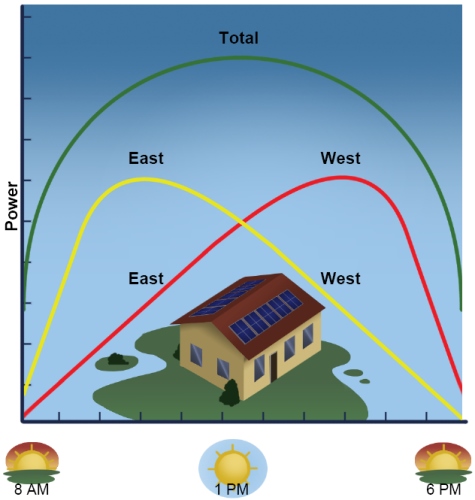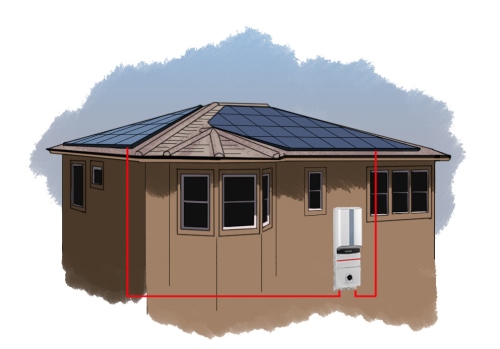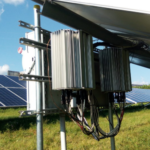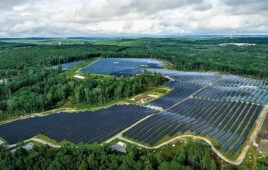Read an updated story from 2019 on inverter MPPT here.
By Roy Allen, technical sales support engineer at Power-One, a member of the ABB Group
MPPT is a four-letter acronym referenced in the solar industry by many, but understood by few. It’s important to understand the definition of MPPT and its functionality, because doing so can help a user improve the energy harvest of his photovoltaic installation, thereby increasing profitability.
What Is A MPPT?
MPPT stands for Maximum Power Point Tracker. It is a circuit (typically a DC to DC converter) employed in the majority of modern photovoltaic inverters. Its function is to maximize the energy available from the connected solar module arrays at any time during its operation.
Why Is A MPPT Necessary?
A solar module is a limited energy DC supply and has internal impedances that vary throughout the course of the day, depending primarily on the level of solar irradiance impinging on the module face and the cell temperature.
An inverter without an MPPT circuit would result in sub-par or non-optimal operating conditions between any PV module (or string of modules) and the inverter. Unless the inverter can match the strings to extract maximum power the result is a lower efficiency operation for the connected strings. The MPPT circuit constantly monitors the array voltage and current. It attempts to drive the operating point of the inverter to the maximum power point of the array, resulting in the highest energy harvest.
Dual vs. Single MPPT
Simply put, in the majority of applications with two strings or more, two MPPTs are better than one. To support this statement, review the table below.
|
Single Inverter Attribute |
Single MPPT |
Dual MPPT |
|
Allow connecting arrays with different solar azimuth angles |
No* |
Yes |
|
Allow connecting arrays with different solar tilt angles |
No* |
Yes |
|
Allow connecting arrays with different string lengths |
No* |
Yes |
|
Allow connecting strings of dissimilar modules |
No* |
Yes |
|
Allow connection more than two strings without combiner fusing |
No** |
Yes |
|
Provide better monitoring granularity |
No |
Yes |
|
* Can be done but results in low harvesting efficiency, lower harvested energy ** Violates NEC requirements. Dual MPPT provides two channels and code allows two strings per input without need for fusing |
||
Considering the entries in the table, an inverter with dual-MPPT functionality allows much greater system design flexibility, significant cost savings and higher levels of harvested energy.
Connecting two arrays with different solar azimuths or tilts, different string lengths (Voc) or different PV modules to a single-channel MPPT inverter would result in a highly inefficient system and, in some instances, an unsafe one.
By accommodating two arrays mounted at different azimuth and/or tilt angles, different string lengths –— even different modules –— into a single inverter increases the design options for installers because it eliminates the need for a second inverter in many situations.

The Maximum Power Point Tracking maximizes energy harvesting during different hours of the day, through changing weather conditions with altering roof pitches and different number of solar panels per string.
Additionally, even for PV systems with all strings facing the same direction, using the dual MPPT function is a better choice. Assume a system has four strings all on a flat roof. If a single MPPT channel is used to connect these to the inverter –— in addition to requiring an external combiner –— if one string is damaged or subjected to higher soiling rates or shading issues, this would affect the output of the entire array and result in a lower overall energy harvest.
Breaking the array into two segments on two MPPT channels will improve system harvesting, because if one string/array is damaged or soiled, the output power of the “good” array at the second MPPT will continue to provide full power, thus providing a higher yield than the single MPPT case. Furthermore, in systems requiring shade mitigation, one MPPT input could operate the shaded array with the other operating the unshaded array.
Historically, without dual-MPPT functionality, efficient interconnection of arrays on two different azimuths required two separate inverters, adding significant material and labor costs to the installation. Dual MPPT provides the installer with faster, less expensive system installation with the capability of handling large and small roof surfaces with different azimuths — all using a single inverter.

This is a great representation of the flexibility dual MPPT’s provide. These solar arrays face South East, and South West (two different Azimuths) and have a different number of solar panels per string. The triangle panels are 72W while the rectangular panels are 144W. Inverters with MPPT channels can accommodate such with optimized energy harvest for the lower installation and material cost than using a single inverter.
Combining up to four strings of PV modules to a single inverter without additional external combiner boxes saves time and materials. The exception of NEC section 690.9 allows connecting two PV strings to a single input of an inverter without a combiner fuse in each string. This is as long as the string wiring is sized properly and there are no other current sources that can back feed into the strings.
If an inverter has dual independent MPPT channels, then up to two strings may be connected per MPPT channel without combiner fuses in each string. Therefore, an inverter with dual-MPPT channels can have up to four strings connected without any external combining hardware.
Over the past few years, the output power rating of most PV modules available on the market has increased substantially such that today’s small residential systems don’t typically need more than two strings. Larger residential applications, however, typically require four strings. Commercial systems require a large number of strings and have historically used larger central inverters and external string combiners. But there is an industry trend of using a multiplicity of smaller inverters for these applications, so a dual MPPT inverter would be advantageous in these designs as well.
MPPT And Monitoring
Single MPPT channel inverters can only provide monitoring data at the entire array level. Whether one, two or four strings, data collection will be based on the overall array input. With independent dual MPPT channels, the inverter can provide monitoring information at the MPPT channel level. As a result, there is a finer granularity in the monitoring data, such as site status, energy production and troubleshooting data. This is important because, depending upon the system design, the loading of the two channels can be different. Therefore, for small systems (with one string per MPPT channel), data collection essentially happens at the string level. For larger residential systems (with up to two strings per MPPT channel), data collection is reported at the two-string level. Therefore, in addition to providing proper energy harvest values per channel, the user can understand what is happening at each input at any time. This can be helpful in troubleshooting abnormal conditions at a given inverter input.
Understanding all these aspects of MPPT can help provide better knowledge of how energy harvesting works and therefore help solar installations become more profitable.






My problem is somewhat different from the problems your correspondents have posted here. I have a camper-converted van with a 455 W solar panel. The installer talked me into setting up a 24 V system. The solar panel and battery each connect separately to a 3 kW Growatt inverter, which also permits shore power connection via MPPT. On off-grid cloudy camping days, the battery can drop pretty low, even though it is 24 V 200 AH. Therefore, I have a desire to charge the 24 V battery from the vehicle 12 V supply, when, of course, the vehicle is running. I have located an Orion Victron 12/24-20 unit that steps 12 V up to 24 V (adjustable up to 30 V) at 20 A. I contemplate using this to charge the solar system 24 V battery. I am hesitant, however, to directly connect the output of such a gadget to either the solar panel or the battery. I wouldn’t expect that a parallel connection directly to the battery would cause a significant problem, as long as the input to the DC-DC converter is off when the ignition switch is off and the circuit is properly fused. Is there a pitfall in this procedure that I am not seeing? It seems that connection of the 24 V line from the DC-DC converter in parallel with the solar panels would waste electricity into the panels. It also seems that the best solution would be a 3-input MPPT device but the inverter has only the two inputs, shore power and PV, and I am finding it difficult to locate even a dual-input standalone MPPT device. Please advise.
Hello, I have a solax 3000 inverter with 2500w on one string and mmpt. Could I add 500w on second string/mmpt to make the most of inverter. Please help Brian
Is it necessary to use both mppts of on grid inverter to get maximum power even if we have all the panels have same azimuth and tilt?
TIA
We have 18 panels of 550watt jinko mounted with same azimuth and tilt.
Shall we connect all in one mppt to get higher voltage
Or split into 9 panels string per mppt
Thanks in advance
I have a question.
My solar inverter has two MPPT controllers but it has total of four solar array inputs. Does one MPPT deals differently with different inputs?
Hi, I have 4 east, 6 West facing panels, 10 degrees tilt, on a flat roof, which actually tilts 5 degrees north. I’d like to have these on two strings into dc1 and DC2 inputs into my dual input inverter. But, installer is concerned that low voltage of the four panel string might delay inverter turning on. My battery trickle discharges when panels are not generating to “keep the inverter on” I’ve been told by the puredrive technician. Does this mean that I should have no concerns about low voltage of the small string, and just go for the two strings set up instead of all on one?
I am planning to have a new house built with 1 small roof facing southeast and 1 longer roof facing southwest. On the southeast roof there is space for 6 panels and on the southwest roof there is space for 10 panels. I plan to connect the panels into 2 strings – 1 string for each roof. The maximum power output from SE roof will be 2.4 kW. The maximum power output from SW roof will be 4.0 kW. My hybrid inverter will have 2 MPPT ports and a MPPT voltage range of 200 – 850 V. The voltage for each panel (without load) will be around 30 volts. So the 6 panel string will produce around 180 volts which is less than the minimum voltage of the MPPT voltage range. Does this mean that I lose all the power from the 6 panel string? How can I solve this problem?
Hello Christian
String 1. 5 panels on SW side + 3 panels from SE side
String 2. 5 panels on SW side + 3 panels from SE side
String 1 and string 2 can also run in parallel into the same MPPT. (same voltage but add the currents )
i have 3 sets of panels going on 3 aspects (east, south, west). the installer only has a dual inverter so wants to connect east and west and use a voltage optimer to fix the inefficiancies. will this work?
adding another inverter and battery for just 3 panels isnt cost effective.
I have a huawei inverter, 15 KW, three phase, with two mppt, four inputs. Because of different orientation of the panels, I needed to put 28 panels on one mppt, on one inputs and 8 on the other mppt. I really dont know, technical, if there is any gain or advantages to divide those 28 panels on both inputs? How can I do this, do I have to make any special connections between the two strings? It is worthy? Thanks
2 antirevers diode!
For dual mppt inverter, it has 2 input ports but if i use single port with 12 modules of 330 wp and left the 2and input port with empty. Then what happens to generation and panels condition.
Is it possible to put 2 different power value on DC1 and DC2 in dual MPPT. I have 9x of 350 watts for DC1 and 4x 360 watts for DC2. thank you for the response.
Hi,
for an inverter with dual MPPTs and 2 DC inputs per MPPT, what will happen if only 1 of the inputs is use for both MPPTs? Ie 1 string connected to MPPT 1 and another string connected to MPPT 2.
hello just have a stupid question, i have hybrid deye inverter 5kw
PV Input Voltage (V) 370 (100~500)
MPPT Range (V) 125~425
Full Load DC Voltage Range (V) 240~425
Start-up Voltage (V) 150
PV Input Current (A) 13+13
my question is in the pv input voltage, the hybrid deye has 2 mppt, does the pv input voltage for single mppt or for 2 mppt?
hi, Asif here
dear my friend,
its for single string ( 240~425v),13A and other string also ( 240~425v) , 13A .
if you want to use double string then on one string voltage series is (240~425) and other string series range ( 240~425) and 13 amp
Hello Asif,
just another quick question adding to Noel’s.
if the inverter max input voltage its 600V, and MPPT Range (V) is 125~425, does this mean I can have 1 string being lets say 370V to 1 mppt and have another string of 370V in another mppt?
And where is the max inverter input (600V) considered?
Thank you
WHAT IS THE REQUIREMENT FOR 4KW SOLAR SYATEM SINGLE MPPT OR DUAL MPPT IVERTER ?
WHICH IS ADVISABLE ?
Sir; i am having an off grid system at my home, 10KW system with a 400w mono crystalline panels qty 10. they have wired up two parellal setup with 5 pannel each. working at 72V (6×12 V Bty) and the system work absolutely ok.
Now i want to know how the following :
1. can i work my same system during day time when sunlight is there with out battery back up ??
2. Can the system work off grid and at same time can my battery can charge and when sunlight is not there this bty can be used for inverter ??
3. how can i function the present system to work directly from solar panel with MPPT with out battery ?
4. How can i get my bty charged during the system work directly on utilities and the charged bty work when there is no power or no light. ??
My INV Device is 8kw on grid with 2 mppt. in that 1 mppt has 2 table string. I have the question why there are 2 strings in 1 mppt. What if the same pv module that I put in 1 chain instead of put in 2 series (voltage condition) ?? Please respond to your responses !! Best regards !!
To increase current strings were added
am having two 275watts solar panels,two 200Ah batteries and 12v/800watts inverter,what is the best solar mppt for this kind of arrangement?
What happens if use only one mppt of solar inverter and make second mppt inputs blank or not connect with pv strings? Does system performance decrease or noting happen to system? Please answer.
Nothing gonna happen
something definitely wrong. If I were you, I would isolate all panels on DC 2 and check voltage across each to identify if one of the panels has gone rogue (Voc, Isc) . If they are all ok, I would then check wire continuity (resistance). Step three would be checking the inverter by the manufacturer or authorized dealer.
What if you’ve got two identical arrays on the same azimuth angle, no shading etc. and the DC1 channel is yielding 324.7 volts, 4.3 amps whilst the DC2 channel is yielding 1.9 volts zero amps.. something wrong?
you probably have a bad connection somewhere along that string DC2. Need to check voltage at those panels for that string. Then see if you are getting the sum of those voltages further along. Best place to start is to check for the voltage at the disconnect of the trouble string first
“… whilst the DC2 channel is yielding 1.9 volts zero amps..”
A little bare (wire) will fix it! Stick with it!
I have recently installed a dual MPPT system at my house. It has 2 sets of panels in different azimuth roof positions. I had been wondering how the 2 arrays work. The explanation of the Dual MPPT system assisted me in understanding how my installation works. However when sun is in different positions the 2 panel sets must produce different outputs of power right? So how do I get aggregate power output of the installation? Is there a way I can monitor the 2 outputs atvany guven time?
Oh by the way I am an electrical engineer so I am technically interested in understanding these solar systems. Send me any data or websites I can get more technical information.
Regards
“[…] …the 2 panel sets must produce different outputs of power right? […]”
Not necessarily. You haven’t said whether your 2 panel sets are the same size or not. Just because they may be situated on different azimuths from each other doesn’t mean that their outputs must be different; plus the measuring of their individual outputs can vary at any given time which is like quoting a finagling-figure not dissimilar to 3/8ths of 13/27ths of 231/232nds ad infinitum.